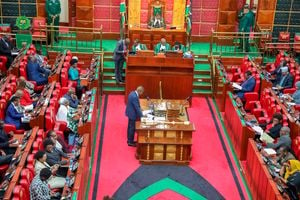
President William Ruto during Diwali celebrations at State House, Nairobi
President William Ruto’s government is seeking a freehand to continue borrowing beyond the legal debt ceiling of 55 percent of the gross domestic product (GDP).
As part of new proposals to be tabled in Parliament, the National Treasury has proposed the extension of coming into force of the debt threshold as a percentage of the GDP to beyond 2028.
This in essence gives the current administration and beyond, a leeway to borrow beyond the set threshold.
Pushing the debt limit implementation time allows Kenya to continue accessing concessional funding from multilateral and bilateral agencies, amid concerns over ballooning public debt.
In June 2023, Parliament approved the conversion of Kenya’s Sh10 trillion debt ceiling with a debt anchor as a percentage of the GDP, setting the debt threshold at 55 percent of the GDP.
The new law gave the Treasury a grace period of five years to implement the new debt ceiling with 2028 the deadline. If implemented immediately, it means the government will not have a borrowing headroom.
At the time, the government was already in breach of the new debt limit as the country’s public debt was already above 70 per cent of the GDP.
In a move that appears cleverly timed to cover President Ruto’s two terms in office, if he were to win a second term in 2027, Treasury is back in Parliament seeking MPs’ nod to extend the five-year grace period and subsequently a blank cheque to continue borrowing.
This is planned to ensure that as the 2028 deadline approaches, there is a new law extending the grace period by another five years.
The new proposal is contained in the Public Finance and Management (Amendment) (No. 4) Bill, 2024 which seeks to amend section 50 of the Public Finance Management Act, 2012, the principal Act.
The amendment bill was published on November 1 and delivered to Parliament three later and is sponsored by the National Assembly Majority Leader Kimani Ichung’wah.
The Section 50(2) of the Act states that the national government may borrow money in accordance with this Act or any other legislation and shall not exceed a limit set by Parliament.
The limit set by Parliament in 2023 was 55 per cent of the GDP with a grace period of five years granted to the Treasury.
In the last year’s amendments as contained in PFM (Amendment) Act, 2023, MPs allowed the national government, in exceptional circumstances, to exceed the set threshold by not more than five percent.
Subsection 2C of the 2023 Act was explicit that the cabinet secretary for Treasury shall, not later than five years from the date of the coming into force of the new law, take measures to ensure that borrowing by the national government complies with the prescribed threshold.
It is this subsection that the Treasury wants deleted and a new subsection that reads that the debt ceiling as a percentage of the GDP shall only come into force on the date that is five years from the date of the commencement of the proposed Act.
But here is the catch in the Bill. The proposed amendment seeks to add a new subsection immediately after subsection 2C, to be known as subsection 2CA.
The new subsection states that the CS shall, not later than five years from the date of the coming into force of this Act, take measures to ensure that borrowing by the national government complies with the prescribed threshold.
“The CS shall, not later than five years from the date of coming into force of this Act take measures to ensure that borrowers by the national government complies with the threshold prescribed in law,” reads the new subsection.
This in essence means that the CS will only be obligated to ensure borrowing conforms to the debt ceiling not earlier than 2032, buying President Ruto more time should he win a second term.
It means that from 2028 when the cap on loans will kick in, the government will have another five years to implement the law.
This means that the earliest the minister for Treasury will be obligated to ensure compliance to the provision of the law will be beyond 2032 when President Ruto shall have completed his second term, should he be re-elected.
Interestingly, the memorandum of the Bill states that the proposed amendment of Section 50 of the Principal Act only seeks to clarify the effective dates of the debt threshold requirement for the CS Treasury to ensure compliance.
As per the latest data from the Central Bank of Kenya (CBK), the total public debt stood at Sh10.6 trillion as of June 2024, compared to Sh10.3 trillion recorded in June 2023.
The present value of public debt was 68.2 per cent of GDP against the approved debt anchor of 55 percent of debt to GDP despite President Ruto's vow to tame the country's appetite for loans.
The public debt was Sh9.14 trillion as of December 2022, rising to Sh9.39 trillion as at the end of March 2023.
The National Assembly’s Public Debt and Privatisation Committee vice chairperson Makali Mulu said Parliament had last year given the government five years to reduce the public debt from the-then 62 percent of the GDP to 55 percent within five years.
The Kitui Central MP said the move means the government is not keen on fiscal consolidation by reducing its expenditure and operating on parameters agreeable internationally.
He noted that Kenya’s public debt is currently around Sh11 trillion, which is around 70 percent of the GDP.
Kenya’s GDP is Sh13.74 trillion or $107.4 billion which will mean that the debt ceiling should not be beyond Sh7.56 trillion (55 percent).
“We gave them a grace period of five years to bring down the public to 55 percent so that that becomes the range. It seems like they are not able to do that and that is why they are seeking to extend the grace period,” said Mr Mulu.
“I don’t think that is the right way to do it because if we keep on borrowing we will be interfering with our intergenerational equity in terms of debt repayment. When the Bill comes before us, it will be debated on its merits,” he added.
The MP said the debt-carrying capacity for Kenya has been assessed to be at around 55 per cent and if the country operates around the percentage, then there will be no concerns of plunging into a debt-distress.
Critics of government borrowing have argued that said the borrowing appetite by the government is strenuous to the economy especially at this time when the cost of living has gone up.
Economist Charles Karissa said the move gives the government a leeway to borrow because Kenya is currently constrained in terms of revenue compared to expenditure.
He said Kenya has mostly been depending on donor funding, especially for development expenditure, and that is why the government has been looking to introduce new taxes through the back as it needs money to service its obligations.
But the challenge is the government has been borrowing money without proof of where the money is going to.
“What the government should have done is to enhance support to institutions given the mandate to fight misuse and leakages of public resources. The government should do more here as opposed to trying to get more funding through borrowing,” said Mr Karissa, CHM Consulting director.
The debt limit ceiling has been a moving target over the years where in 2019, Parliament successfully adjusted the borrowing headroom to Sh9 trillion from Sh6 trillion.
But after the government burst the ceiling, the Treasury went back to Parliament in 2022 urging MPs to increase the debt ceiling from Sh9 trillion to Sh10 trillion in order to enable the government to borrow more to finance its Sh3.3 trillion budget for the financial year ending June 30, 2023.
This was by amending regulation 26 of the PFM (National Government) Regulations, 2015 – which had capped the debt ceiling at Sh9 trillion – and replacing it with the public debt shall not exceed Sh10 trillion.
As part of the amendments, the Treasury sought to revert to a debt ceiling that is calculated according to the Gross Domestic Product of the country, the cap on public debt was set at 55 percent of the GDP.











